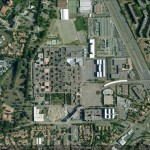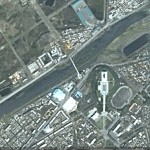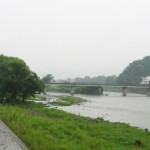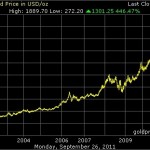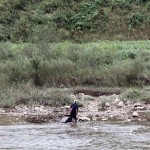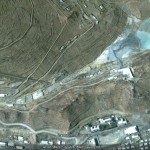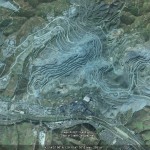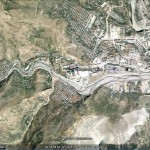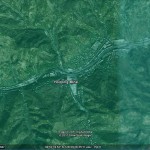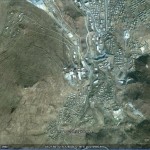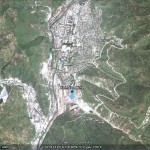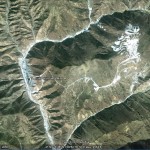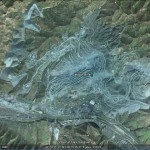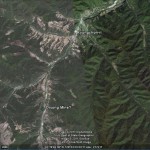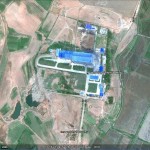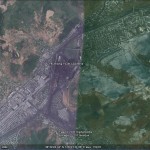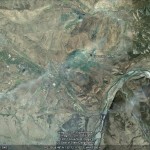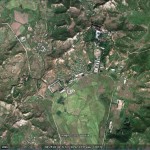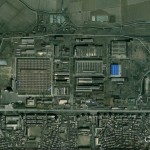Pictured above (Google Earth): The University of Toulouse, France. See in Google Maps here.
According to AlertNet (Reuters):
Secretive and isolated North Korea is searching for economic allies in the unlikeliest of ways: showing videos of happy North Korean tourists to young French university students in a 13th century convent.
The reclusive communist state has no official diplomatic relations with France, one of only two European Union countries to cut ties with North Korea until it abandons its nuclear weapons programme and improves its human rights record.
But just weeks after Paris decided to open a cooperation office in the North Korean capital, its ambassador to Paris-based UNESCO accepted an invitation to address students from the University of Toulouse within the gothic surroundings of the Franciscan convent’s capitular chamber.
The meeting marked Ambassador Yun Yong Il’s first public appearance in France.
“They are the future,” said Yun, when asked by Reuters why he picked Toulouse to talk. “I’m here for the students who have been waiting to hear from a North Korean official for a year.”
Tensions have gradually eased on the Korean peninsula since the sinking of a South Korean warship 20 months ago and the North’s revelation of a uranium enrichment facility that opens a second route to make an atomic programme.
North Korea and the United States have also held a series of bilateral meetings geared at restarting broader regional de-nuclearisation talks, giving the North a window of opportunity to raise its diplomatic efforts around the world.
Yun, a former political director at the Foreign Ministry, faced about 100 students.
At times, the future political science graduates looked on bemused and surprised as the four-hour presentation cut from a hazy tourism video of the 1980s showing rolling mountains, happy North Koreans on holiday and copious seafood platters to a well structured monologue about the country’s woes and potential.
“Our country is open to everybody who wants to come. You just have to ask for a visa in Paris!” said Yun, who speaks fluent French, but opted to talk in his native language and let his deputy translate into English.
Pyongyang has slowly opened its doors under strict conditions to foreign tour groups, mostly Chinese as a way of earning hard currency.
Yun, who wears a lapel pin of President Kim Jong-il on his suit, said the country’s lack of hard currency as a result of tighter sanctions has made it turn to foreign investors on the “basis of mutual respect and interests”.
“We are looking forward to multilateral and multifaceted economic co-operation with other countries,” he said.
“We are definitely opposed to monopolistic investment of a single country,” said Yun, adding that the country’s natural resources provided opportunities for investors to tap.
CHINESE MODEL, CHINA TRAP
Michel-Louis Martin, director of Toulouse University’s security and globalisation research group said the event was not just propaganda.
“They are trying to go beyond what they usually have to say about North Korea. Don’t forget in France, North Korea is not very well known,” said Martin.
The country’s desire to diversify its economy has echoes of China when it began to allow foreign investment and gave permission for entrepreneurs to start up businesses in the 1970s.
Yun’s presentation attempted to steer clear of its frictions with the United States, South Korea and even its relationship with China, focusing instead on his country’s economic problems.
But by the end he stepped up the rhetoric, firmly laying the blame for Pyongyang’s “misfortune” on the United States.
Michel Dusclaud, a researcher at the University of Toulouse who convinced Yun to speak, said it was normal for ancestral hatreds to come out. Despite this, he said, it was clear the North was beginning to accept that if it did not diversify, it would be engulfed either by its souther neighbour or China, which still has territorial claims to it.
“They have to open up for international cooperation otherwise they will be eaten up by South Korea or China,” Dusclaud said. “It’s imperative, but it’s not because they like us.”
With his speech finished, Yun was quick to shuffle out of the Gothic chapel, declining to speak to Reuters, but also telling a student who attempted to pose a question on whether North Korea’s political system could last:
“I’ll see you in Paris and then we’ll talk.”
Read the full story here:
N.Korea makes discreet investor plea to French students
AlertNet (Reuters)
John Irish
2011-11-24
